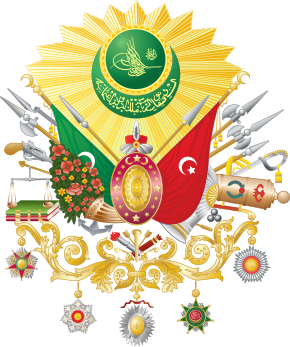At the heart of the design is a shield adorned with a turban, which serves as the "crown" of the Ottoman monarch. Above the shield, a sun symbolizes the grandeur of the nation, upon which the sultan's tughra and chosen motto are inscribed. To the left, a red book and a green book represent the Islamic and modern laws of the empire. Atop these books, a scale stands as a symbol of justice. The blooming flowers near it also represent justice in Islamic symbolism. Encircling the shield are an assortment of weapons, balancing ancient armaments with modern weaponry. A red flag representing the secular institutions of the state stands alongside the green Standard of the Caliph. Beyond the coat, the Ottoman Orders of Merit are displayed.[1][2]
At the top, golden light rays radiate from the sun with the tughra seal of the sultan inscribed in golden letters on a green disk background. The tughra reads in Arabic, "Mahmud Khan son of Abdulhamid, forever victorious", written out as: محمود خان بن عبد الحميد مظفر دائماً (Mahmūd Ḫān bin Abdulhamīd muẓaffar dāʾimā). The inscription in the large green crescent reads in Arabic: "Relying on Divine success, the king of the Sublime Ottoman State", written out as: المستند بالتوفيقات الربانية ملك الدولة العلية العثمانية (al-Mustanidu bi't-Tawfiqāti'r-Rabbānīyah Malik ad-Dawlatu'l-Alīyati'l-Uthmāniyah).[3]
Hanging beneath the lower flourish are the medals of five Ottoman military decorations. In the main image, from left to right they are: the Order of Charity, the Order of the Medjidie, the Order of the Crescent, the Order of Osmanieh, and the Order of Distinction. Other than the number of medals, the arrangement and type of medals featured were never standardised.
In keeping with the Islamic proscription against depicting animate beings, no animals such as supporters are included in the design.
